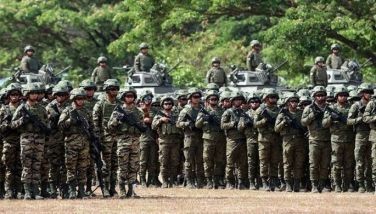Quo Vadis, Asean?

One of the geographical centers of the US-China struggle for global dominance is Southeast Asia. In other geographical areas, this conflict between the liberal democracies and the authoritarian states has resulted in violence. Some examples of this are Africa, the Middle East and even Europe.
In Europe, the Russian invasion of Ukraine has brought warfare to the most prosperous continent in the world. In 1993, Aaron Friedberg, a political scientist, wrote that “Asia was more likely than Europe to become the cockpit of great power conflict.” Asia’s last major conflict, however, was the Vietnam War which ended in 1979.
Thus far, after more than 40 years, East Asia has remained a region of relative peace. Though there is significant religious and ethnic diversity in this region, it has remained remarkably peaceful and harmonious. The only conflicts that have occurred have been internal conflicts such as the one in Myanmar.
At the same time, Southeast Asia has also prospered as the living standards in the United States and Europe have remained relatively flat in the last two decades. Southeast Asians have achieved economic and social development gains.
Unfortunately, one notable exception is the Philippines. During the term of president Benigno Aquino III, the Philippines was considered a rising tiger economy. During the term of the succeeding president, the Philippines failed to achieve its status as a rising economy. In the past administration, countries like Indonesia and Vietnam, which used to lag behind the Philippine economy, soon overtook our country in terms of economic size and prosperity.
This period of growth and harmony in Southeast Asia has been forged based on cooperative regional order. The region has also somehow been able to steer clear of the conflict between China and the United States. Thus far, it seems that the major powers see the ASEAN as basically neutral and independent.
Even though the region tries to cultivate closer relations with China, it is also determined to maintain close ties with the United States. Trade with China, the United States and Japan has also contributed to the ASEAN’s remarkable economic rise.
In 2000, the region’s combined GDP was $600 billion which is 1/8 of Japan’s GDP. In 2021, it was already $3 trillion compared to Japan’s $5 trillion. By the year 2030, the projection is that the ASEAN economy will be larger than Japan’s economy. Hopefully, the Philippines will be able to shake off its economic malaise and join the rest of the ASEAN countries in its march to economic prosperity.
The one looming geopolitical problem of the region is its geographic proximity to China, which means that there will be challenges dealing with China. Already, disputes have risen over the South China Sea (SCS) which China claims as its territory. There are now disputing territorial claims between China and five ASEAN countries, namely Brunei, Indonesia, Malaysia, Philippines and Vietnam.
The ASEAN region has been asking for a Code of Conduct agreement for the SCS that would reduce the risk of conflict in this disputed territory. As of this date, China has refused, based on its claim of sovereignty over the SCS. Ideally, the ASEAN region should not be forced to choose between Beijing and Washington. There was a time when the belief was that Beijing would be a source of more development assistance than the United States. During the past administration in the Philippines, this has not been proven to be the case. There was very little development aid coming from China.
The Philippine experience is that the biggest source of overseas development assistance is coming from Japan. The Metro Manila subway project is being primarily funded by Japan.
Another source of development funding for the Philippines is South Korea. The United States has primarily offered assistance in terms of defense cooperation and arms sales. While this was not a major benefit in previous times, recent aggressive actions by China have made this defense cooperation vital to Philippine security.
China has illegally invaded and taken over territory within the Philippine Exclusive Economic Zone (EEZ). The most recent incident is the interception by a Chinese Coast Guard vessel of a Philippine marine vessel on its way to resupply a small Philippine outpost in the Ayungin Shoal. The Chinese used water cannons to intercept and force the smaller Philippine vessel to retreat. This has caused an understandably strong reaction from the Filipino people.
The Philippine government has vowed that it will not stop trying to resupply the gallant garrison at the Ayungin Shoal. A spokesman for the Philippine Coast Guard went further by saying that anyone who is pro-China is a traitor to the Filipino people.
The world is now waiting to find out how far this policy of aggression by the Xi Jinping government will go. One major consideration is that the Chinese economy is going through a troublesome period. Its foreign trade has decreased and its economic slowdown has caused forecasts of possible deflation in China.
The Philippines now faces two major challenges. The first is that it must rejuvenate its economy from the period of stagnation caused by the past administration. The second is that it must seek peaceful resolution to the conflicts in the SCS while at the same time strengthen its capability in the event that a show of force will be necessary.
* * *
Email: [email protected]
- Latest
- Trending




























